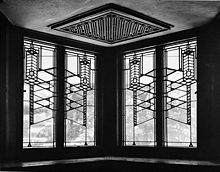User:Levigriffith/Personalsandbox


Personal Sandbox
Plans to expand this page include the following:
- Addition of relevant sub-categories under "History of Interior Architecture"
- Addition of relevant sub-categories under "Roles of Interior Architects"
- Addition of relevant content under "Initial Design", "Job Descriptions" and "Schools of Interior Architecture"
- Addition of relevant photographs, diagrams and various media to illustrate interior architecture
- Locate and utilize more credible references
Levi Griffith (talk) 20:59, 2 February 2011 (UTC)
ONLY EDIT CONTENT BELOW[edit]
Interior Architecture (Latin penitus architectura, from the Greek εσωτερικός - esoterikos "interior" and ἀρχιτέκτων – arkhitekton "chief builder, carpenter, or mason") is truly a marriage of three distinct design disciplines: interior design, architecture, and industrial design. Interior design focuses on the selection of interior materials, finishes, and furnishings; architecture on the design of building forms and systems; and industrial design on the design of manufactured products.[2] Another definition is the specific features of a building's interior. It can also be the initial design and plan for use, the later redesign to accommodate a changed purpose, or a significantly revised design for adaptive reuse of the building shell. [3] The latter is often part of sustainable architecture practices, conserving resources through 'recycling' a structure by adaptive redesign. Generally referred to as the spatial art of environmental design, form and practice, interior architecture is the process through which the interiors of buildings are designed, concerned with all aspects of the human uses of structural spaces.
Interior architecture can refer to:
- The art and science of designing and erecting building interiors and related physical features.
- The practice of an interior architect, where architecture means to offer or render professional services in connection with the design and construction of a building's interior that has as its principal purpose human occupancy or use.[4]
- A general term to describe building interiors and related physical features.
- A style or method of design and construction of building interiors and related physical features.
History of Interior Architecture[edit]
Content in progress.
Roles of Interior Architects[edit]
Initial Design[edit]


Content in progress.
Adaptive Reuse[edit]



Although the original spatial hierarchy of a building is always established by its first architect, subsequent iterations of the interior may not be, and for obvious reasons, older structures are often modified by designers of a different generation according to society’s changing needs as our cities evolve. This process often re-semanticizes the building as a consequence, and is predicated on the notion that buildings can never really be complete and unalterable.
An altered building may look the same on the exterior, but its interior may be completely different spatially. The interior architect must therefore be sensitive not only to the place of the building in its physical and socio-political context, but to the temporal requirements of changing owners and users. In this sense, if the building has “good bones” the original architectural idea is therefore the first iteration of an internal spatial hierarchy for that structure, after which others are bound to follow
Cities are now dense with such buildings, perhaps originally built as banks that are now restaurants, perhaps industrial mills that are now loft apartments, or even railway stations that have become art galleries. In each case the collective memory of the shape and character of the city is generally held to be more desirable than the possibility of a new building on the same site, although clearly economic forces apply. It is also possible to speculate that there might well be further new interiors for these structures in future years, but for each alteration the technical and technological expertise of the era will determine the extent to which the building is modified in its building life cycle.
Certain structure's interiors remain unaltered over time due to historic preservation, unchanged use, or financial limitations. Nevertheless, most buildings have only three possible long-range internal futures: First, designated significantly important to maintain visually unchanged, only accommodating unseen modern utilities, access, and structural stabilization, and restoration needs. Second, demolished to make way for a new building on the same site, or abandoned, becoming ruins. Finally, redesigned and altered to accommodate new uses.
There are many different degrees of alteration – a minor one to enable the building to conform to new legal codes is likely to prolong the first (or indeed later) iteration of interior space, but a major alteration, such as the retention of only the facade, is to all intents and purposes a new building. All possibilities within and between the two extremes are the domain of the interior architect.
If the practice of Architecture is concerned with the art and science of new building, then the practice of Interior Architecture is concerned with the alteration of existing buildings for new uses.[7]
Careers in Interior Architecture[edit]
Professions[edit]
Many of the new graduates from architecture design schools go to work for specialized firms, while some work for residential or nonresidential building construction agencies. Others go to work for the government, taking jobs in bureaus that deal with the development of housing and communities. The traditional professions of an interior architect include:
- Architect
- Construction Manager
- Industrial Designer
- Landscape Architect
- Urban Planner and Developer
- Interior Architecture Expert
Other related jobs can include:
- Principal or professor in an architectural design school
- Architecture critic
- Architecture photographer
- Real estate project manager
- Civil engineering
It’s also important to remember that students who participate in internships during their study years gain better knowledge and skills when it comes to applying lessons learned in the classroom to actual work. Many interns join the company where they interned once they have graduated and completed the educational, examination and licensure requirements set by their State.[8]
Salary[edit]
New graduates who enter the field of interior architecture at entry-level, earn an estimated $40,000 per year. However, depending on various things such as an individuals education levels, experience, licenses, employment history and employment location can determine whether or not an interior architect is making more or less than the average median wage. Also, depending on an individual’s flexibility, he or she may consider going into business for his or herself, where salaries have the potential of being much more per year.
Being employed by a company versus self-employment has its benefits, as well as its drawbacks. One benefit to being your own boss is utilizing your creativeness, unique designs and intelligence to complete a project. However, the downside to being your own boss is lacking the expertise of interior architects who have been around longer, have more connections and a bigger client base. When you are self-employed you rely heavily on yourself to complete the project, which requires long hours and a decreased amount of hourly pay. [9]
Statistics from the Bureau of Labor Occupational Handbook show that the median annual wages of wage-and-salary architects were $70,320 in May 2008. The middle 50 percent earned between $53,480 and $91,870. The lowest 10 percent earned less than $41,320, and the highest 10 percent earned more than $119,220. Those just starting their internships can expect to earn considerably less.
Earnings of partners in established architectural firms may fluctuate because of changing business conditions. Some architects may have difficulty establishing their own practices and may go through a period when their expenses are greater than their income, requiring substantial financial resources.
Many firms pay tuition and fees toward continuing education requirements for their employees. [10]
Education and Interior Architecture[edit]
Purpose[edit]
Education in interior architecture should include the study of historic architectural and design styles, building codes and safety, preserving and restoring old buildings, drawing plans of original designs, and building physical and virtual (computer-based) models. The field of interior architecture has a lot in common with interior design and decorating; however, it typically focuses on architecture and construction. Students of both fields learn to design comfortable, safe, and useful indoor spaces, from downtown penthouses to high school classrooms. A student of interior architecture will learn about much more than artistic concerns, such as choosing which style of furnishings works well in an open, loft-like apartment. Study will also include information on technical issues, such as seismic retrofitting (making old buildings safe from earthquakes). [11]
Degree Programs[edit]
Interior Architecture stands at the intersection of architecture, design of the built environment, and conservation. Interior architecture programs address the design issues intrinsic to the re-use and transformation of existing structures through both an innovative and progressive approach.
The National Center for Education Statistics states that the definition of a degree program in interior architecture is: "A program that prepares individuals to apply architectural principles in the design of structural interiors for living, recreational, and business purposes and to function as professional interior architects. Study includes instruction in architecture, occupational and safety standards, structural systems design, heating and cooling systems design, interior design, specific end-use applications, and professional responsibilities and standards." [12]
In addition to earning a degree in interior architecture, general licensure is required to work within the United States and some states have further licensing requirements. [13] In many European countries the use of the title "Interior Architect" is legally regulated. This means that a practicing professional cannot use the title of "Interior Architect" unless they complete the requirements for becoming a registered or licensed architect as well as completing a degree program. [14]
Schools of Interior Architecture[edit]
Degree programs in Interior Architecture include:
- University of North Carolina at Greensboro, Department of Interior Architecture [15]
- Rhode Island School of Design (RISD), Interior Architecture Graduate Department. [16] [17]
- University of Oregon, Interior Architecture Department [18]
- University of Sint-Lucas Ghent and Brussels, Interior Architecture Department [19]
See also[edit]
References[edit]
- ^ http://www.archi-ninja.com/excellent-examples-of-adaptive-reuse/
- ^ http://www.uncg.edu/iar/info/about.html
- ^ http://intar.risd.edu/
- ^ http://www.gov.ns.ca/legislature/legc/bills/60th_1st/3rd_read/b115.htm
- ^ "Frank Lloyd Wright: His Life and His Architecture," Twombly, Robert C., John Wiley and Sons, Inc., 1979, p. 384.
- ^ http://www.archi-ninja.com/excellent-examples-of-adaptive-reuse/
- ^ http://intar.risd.edu/
- ^ [1]
- ^ [2]
- ^ Bureau of Labor Statistics Occupational Outlook Handbook 2010-2011
- ^ College Board http://www.collegeboard.com/csearch/majors_careers/profiles/majors/04.0501.html
- ^ The National Center for Education Statistics: Definition of Interior Architecture http://nces.ed.gov/pubs2002/cip2000/ciplist.asp?CIP2=04/
- ^ http://education-portal.com/articles/Become_an_Interior_Architect_Step-by-Step_Career_Guide.html
- ^ ECIA: European Council of Interior Architects http://www.ecia.net
- ^ UNCG Department of Interior Architecture
- ^ RISD Interior Architecture Graduate Department website
- ^ RISD.edu RISD Interior Architecture overview
- ^ University of Oregon Interior Architecture Department website
- ^ University of Sint-Lucas Ghent Architecture Department website
